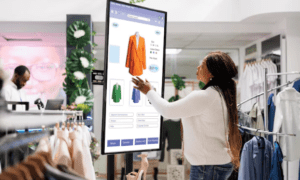Staying ahead of the curve is essential for tech companies aiming to carve their niche in the competitive market. Traditional marketing methods are gradually becoming obsolete, making room for innovative approaches that captivate audiences in unique ways. Two cutting-edge technologies that have taken the marketing world by storm are Augmented Reality (AR) and Artificial Intelligence (AI). Integrating these technologies into branding campaigns not only enhances user engagement but also revolutionizes the way consumers perceive tech products and services.
Introduction
The Rise of Augmented Reality in Marketing
AR, overlaying digital content on the real world via smartphones and AR glasses, benefits marketing significantly. Unlike VR’s immersive digital environment, AR enhances reality with interactive elements. In tech branding, AR aids real-time product visualization, enhancing informed decision-making.
Imagine a customer walking into an electronics store, scanning a QR code, and instantly seeing a 3D hologram of the latest smartphone model appearing on their screen. They can rotate it, explore its features, and even see how it fits into their daily lives. This immersive experience creates a lasting impression and significantly influences purchasing decisions.
AI-Powered Personalization
On the other hand, Artificial Intelligence has revolutionized the way brands understand and interact with their audience. AI algorithms analyze vast amounts of data to identify patterns, preferences, and behaviors. This invaluable insight enables tech companies to tailor their marketing strategies for individual consumers, creating a sense of personal connection.
For instance, AI-powered chatbots provide instant customer support, answering queries and providing recommendations based on the user’s previous interactions. These chatbots not only enhance customer satisfaction but also collect valuable data, allowing companies to refine their products and services further.
The Symbiotic Relationship between AR and AI
The power of combining AR and AI in tech branding lies in how they work together. AR makes content visually appealing, while AI personalizes it based on user preferences. For example, AI can analyze user interests to show AR content relevant to them..
Moreover, AI can enhance AR experiences by making them more interactive and responsive. Through facial recognition and gesture tracking, AR applications can respond to users’ expressions and movements, creating an immersive and personalized experience. This level of interactivity not only captivates users but also fosters a sense of connection with the brand.
Benefits of Integrating AR and AI in Tech Branding Campaigns
Enhanced User Engagement:
The immersive and interactive nature of AR, coupled with AI-driven personalization, ensures that users are not just passive observers but active participants in the brand experience. This heightened engagement leads to longer interaction periods and increased brand recall.
Data-Driven Decision Making:
AI algorithms collect and analyze user data generated by AR interactions. This data provides valuable insights into consumer preferences and behavior, enabling companies to make data-driven decisions to refine their marketing strategies continually.
Boosted Sales and Conversions:
When customers can visualize and interact with products in real-time, their confidence in purchasing decisions increases. The personalized recommendations from AI further influence their choices, leading to higher conversion rates and increased sales.
Brand Differentiation:
Tech companies that embrace AR and AI in their branding campaigns differentiate themselves from competitors. By offering innovative and personalized experiences, they create a distinct brand identity that resonates with consumers.
Cost-Effectiveness:
While the initial implementation of AR and AI technologies may require an investment, the long-term benefits outweigh the costs. Personalized marketing reduces wasteful spending on generic advertisements, ensuring that resources are allocated efficiently.
Conclusion
In the world of tech branding, combining Augmented Reality and Artificial Intelligence is the future of marketing. By using AR’s immersive experiences and AI’s personalized data, tech companies can make powerful campaigns that connect with their audience. As these technologies progress, businesses that use this combination will not just be current but also succeed in the digital age. Next-Gen Marketing is here, changing how we see and use technology, one augmented experience at a time.





























